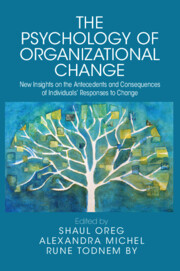 The Psychology of Organizational Change
The Psychology of Organizational Change An Examination of Sensemaking Processes in a Change Management Competency Intervention
from Part IV - The Development of Change Leadership
Published online by Cambridge University Press: 28 September 2023
Managers act as change agents on the frontlines of the day-to-day implementation of change processes at the same time as having to manage daily operations. This double role puts them under pressure to both implement change processes efficiently and emphasizes the need for tools and techniques to develop the change competencies of managers. This chapter addresses this issue by presenting a case study of a change management competency intervention. The intervention lasted four days of workshops and consisted of dialog exercises and serious-game simulations. The participating managers were presented with change dilemmas related to key change concepts such as change phases, change resistance/readiness, and balancing change and stability, with the aim to improve their change competencies. Drawing on interviews with managers participating in the training we analyze how the intervention challenged the managers’ perspectives on their change management and fostered learning and development of change competencies. The key role of sensemaking processes are analyzed to nuance and theorize the complexities of developing change competency.
To save this book to your Kindle, first ensure no-reply@cambridge.org is added to your Approved Personal Document E-mail List under your Personal Document Settings on the Manage Your Content and Devices page of your Amazon account. Then enter the ‘name’ part of your Kindle email address below. Find out more about saving to your Kindle.
Note you can select to save to either the @free.kindle.com or @kindle.com variations. ‘@free.kindle.com’ emails are free but can only be saved to your device when it is connected to wi-fi. ‘@kindle.com’ emails can be delivered even when you are not connected to wi-fi, but note that service fees apply.
Find out more about the Kindle Personal Document Service.
To save content items to your account, please confirm that you agree to abide by our usage policies. If this is the first time you use this feature, you will be asked to authorise Cambridge Core to connect with your account. Find out more about saving content to Dropbox.
To save content items to your account, please confirm that you agree to abide by our usage policies. If this is the first time you use this feature, you will be asked to authorise Cambridge Core to connect with your account. Find out more about saving content to Google Drive.